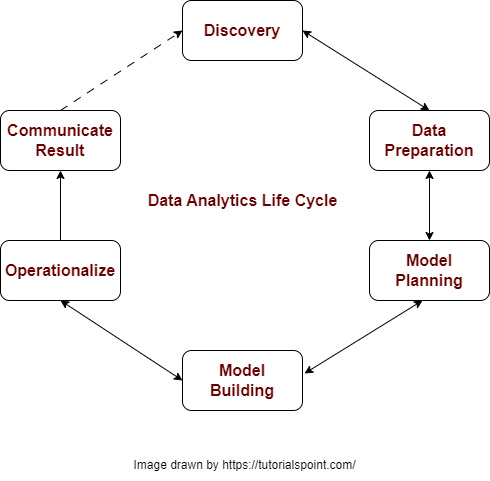
 Data Structure
Data Structure Networking
Networking RDBMS
RDBMS Operating System
Operating System Java
Java MS Excel
MS Excel iOS
iOS HTML
HTML CSS
CSS Android
Android Python
Python C Programming
C Programming C++
C++ C#
C# MongoDB
MongoDB MySQL
MySQL Javascript
Javascript PHP
PHP
- Selected Reading
- UPSC IAS Exams Notes
- Developer's Best Practices
- Questions and Answers
- Effective Resume Writing
- HR Interview Questions
- Computer Glossary
- Who is Who
Model Planning for Data Analytics
In this article, we will discuss Model Planning for Data Analytics, Role Models and Challenges in Model Planning. We will also discuss the importance of model planning and ways to make an effective model plan.
Data analytics is an important component of business strategy nowadays. It helps businesses make informed decisions by extracting meaningful insights from large amounts of data. But model planning plays an important role in data analytics. Model planning involves selecting the right analytical models and techniques that will effectively analyze and interpret the data, thereby helping in making accurate decisions.
Data Analytics
Data analytics is the process of examining large datasets to uncover patterns, relationships, and insights. These can inform business decisions. This process includes data collection, data preparation and cleaning, data modeling, analysis and interpretation. Data preparation and cleaning are especially important. These ensure that the data is accurate, complete and ready for analysis.

Role of Models in Data Analytics
A model is a process that helps explain the relationships between different variables. With the help of models, we can identify patterns in data, make predictions and make informed decisions. There are different types of models used in data analytics. These are important regression models, clustering models, decision trees and neural networks.
Model Planning in Data Analytics
Model planning is the process of selecting the right analytical models and techniques. These chosen models will be used to analyze the data. If the chosen analytical model is suitable for the data and business problem, then that model is known as effective model planning. Proper model planning involves several important steps. These steps are ?
Defining the problem,
Determining data requirements,
Selecting the appropriate model,
Evaluating the model's performance.
Factors to Consider in Model Planning
These are important factors to consider in model planning ?
Business Problem
This is the first factor to consider. The problem should be clearly defined and determine what kind of precise information you want from the data.
Data Availability
Relevant data must be accessible and it is accurate and complete. This means that you need to consider quality and availability of the data.
Data Types
Categorical or numeric data types are also important parameters when you choose the appropriate data model.
Model Complexity
There should be balance between model complexity and accuracy.
Performance Metrics
It should be aligned to the business problem given. You need to select the appropriate performance metrics to evaluate the effectiveness of the model.
Interpretability
It should be easy to understand and explain to the stakeholders.
Challenges in Model Planning
Process of designing and building the model is known as model planning. It involves several steps. These steps just may have challenges encountered during the model planning process. These challenges are given below.
Defining the problem
Data collection and preparation
Model selection
Training the model
Evaluating the model
Every stage has its own challenges. These are common challenges: selecting the appropriate model, selecting the right data, and evaluating the model's performance.
Common Tools for the Model Planning Phase
These are several tools available for the model planning phase.
Jupyter Notebooks
Jupyter Notebook is an open-source web application. It allows users to create and share documents. These documents can include live code, equations, visualizations, and descriptive text. It is a popular tool for data exploration, prototyping and collaboration in the model planning phase.
Python or R
Python and R are popular programming languages used for data analysis and machine learning. They contain many libraries and packages. Such as scikit-learn, tensorflow, keras and pytorch, which can be used to develop and train models.
Data visualization tools
Tableau, Power BI and matplotlib are data visualization tools. These tools can be used to visualize and explore data. We can identify patterns, trends and outliers in the data with the help of these tools.
GitHub
GitHub is a web based platform. It allows users to host, share and collaborate on code repositories. GitHub is used for version control, code review, collaboration etc.
Cloud computing platforms
These are AWS (Amazon Web Services), GCP (Google Cloud Platform), and Microsoft Azure. These provide scalable computing resources. Such as virtual machines, containers, and serverless computing, which can be used to train and deploy models.
Automated machine learning tools
These are H2O.ai, DataRobot, and Google AutoML. These can automate several tasks in the model planning phase, such as data preprocessing, feature selection, model selection, and hyperparameter tuning.
In summary, the choice of tools for the model planning phase depends on the specific needs of the project. such as the expertise of the team and the resources available. But, the above mentioned tools are some of the most common and used tools in the model planning stage

